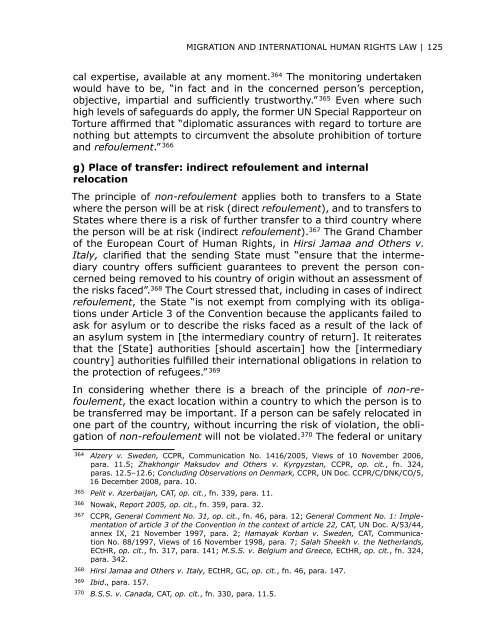Universal-MigrationHRlaw-PG-no-6-Publications-PractitionersGuide-2014-eng
Universal-MigrationHRlaw-PG-no-6-Publications-PractitionersGuide-2014-eng
Universal-MigrationHRlaw-PG-no-6-Publications-PractitionersGuide-2014-eng
Create successful ePaper yourself
Turn your PDF publications into a flip-book with our unique Google optimized e-Paper software.
MIGRATION AND INTERNATIONAL HUMAN RIGHTS LAW | 125<br />
cal expertise, available at any moment. 364 The monitoring undertaken<br />
would have to be, “in fact and in the concerned person’s perception,<br />
objective, impartial and sufficiently trustworthy.” 365 Even where such<br />
high levels of safeguards do apply, the former UN Special Rapporteur on<br />
Torture affirmed that “diplomatic assurances with regard to torture are<br />
<strong>no</strong>thing but attempts to circumvent the absolute prohibition of torture<br />
and refoulement.” 366<br />
g) Place of transfer: indirect refoulement and internal<br />
relocation<br />
The principle of <strong>no</strong>n-refoulement applies both to transfers to a State<br />
where the person will be at risk (direct refoulement), and to transfers to<br />
States where there is a risk of further transfer to a third country where<br />
the person will be at risk (indirect refoulement). 367 The Grand Chamber<br />
of the European Court of Human Rights, in Hirsi Jamaa and Others v.<br />
Italy, clarified that the sending State must “ensure that the intermediary<br />
country offers sufficient guarantees to prevent the person concerned<br />
being removed to his country of origin without an assessment of<br />
the risks faced”. 368 The Court stressed that, including in cases of indirect<br />
refoulement, the State “is <strong>no</strong>t exempt from complying with its obligations<br />
under Article 3 of the Convention because the applicants failed to<br />
ask for asylum or to describe the risks faced as a result of the lack of<br />
an asylum system in [the intermediary country of return]. It reiterates<br />
that the [State] authorities [should ascertain] how the [intermediary<br />
country] authorities fulfilled their international obligations in relation to<br />
the protection of refugees.” 369<br />
In considering whether there is a breach of the principle of <strong>no</strong>n-refoulement,<br />
the exact location within a country to which the person is to<br />
be transferred may be important. If a person can be safely relocated in<br />
one part of the country, without incurring the risk of violation, the obligation<br />
of <strong>no</strong>n-refoulement will <strong>no</strong>t be violated. 370 The federal or unitary<br />
364 Alzery v. Sweden, CCPR, Communication No. 1416/2005, Views of 10 November 2006,<br />
para. 11.5; Zhakhongir Maksudov and Others v. Kyrgyzstan, CCPR, op. cit., fn. 324,<br />
paras. 12.5–12.6; Concluding Observations on Denmark, CCPR, UN Doc. CCPR/C/DNK/CO/5,<br />
16 December 2008, para. 10.<br />
365 Pelit v. Azerbaijan, CAT, op. cit., fn. 339, para. 11.<br />
366 Nowak, Report 2005, op. cit., fn. 359, para. 32.<br />
367 CCPR, General Comment No. 31, op. cit., fn. 46, para. 12; General Comment No. 1: Implementation<br />
of article 3 of the Convention in the context of article 22, CAT, UN Doc. A/53/44,<br />
annex IX, 21 November 1997, para. 2; Hamayak Korban v. Sweden, CAT, Communication<br />
No. 88/1997, Views of 16 November 1998, para. 7; Salah Sheekh v. the Netherlands,<br />
ECtHR, op. cit., fn. 317, para. 141; M.S.S. v. Belgium and Greece, ECtHR, op. cit., fn. 324,<br />
para. 342.<br />
368 Hirsi Jamaa and Others v. Italy, ECtHR, GC, op. cit., fn. 46, para. 147.<br />
369 Ibid., para. 157.<br />
370 B.S.S. v. Canada, CAT, op. cit., fn. 330, para. 11.5.



